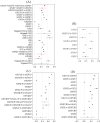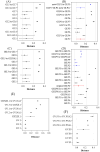A dual typing system establishment and global diversity analysis for sapoviruses
- PMID: 39578768
- PMCID: PMC11583745
- DOI: 10.1186/s12864-024-11048-w
A dual typing system establishment and global diversity analysis for sapoviruses
Abstract
Background: The genus Sapovirus in the family Caliciviridae comprises of a genetically diverse group of viruses that are responsible for causing acute gastroenteritis in both human and animals globally. As the number of sequences continues to grow and more recombinant sequences are identified, the classification criteria of genogroups and genotypes of sapovirus need to be further refined. In this study, we aimed to optimize the classification of sapoviruses.
Results: Through evolutionary clustering and genetic distance analysis, we have updated the classification criteria for VP1 genogroup and genotypes. We adjusted the original mean values ± 3 standard deviations (SD) of genetic distances to mean values ± 2.5SD, resulting the corresponding cutoff values for the same genotype and genogroup set at <0.161 and <0.503, respectively. Additionally, we established classification criteria for RdRp types and groups, referred to as P-types and P-groups,, with mean values ± 2SD and cutoff values of <0.266 and <0.531 for the same type and group, respectively. This refinement has expanded the VP1 genogroups to thirty-four and identified twenty-four P-groups. For human sapoviruses, the new criteria have resulted in the addition of one genotype, GV.PNA1. Moreover, the new criteria defined three P-groups and 21 P-types for human sapoviruses. Spatial-temporal analysis revealed no specific distribution pattern for human sapoviruses.
Conclusions: We established a dual typing system on classification based on VP1 and RdRp nucleotide sequences for sapoviruses.
Keywords: Classification; Dual-typing; Genetic distance; Genogroup; Genotype; Sapoviruses.
© 2024. The Author(s).
Conflict of interest statement
Declarations. Ethics approval and consent to participate: Not applicable. Consent for publication: Not applicable. Competing interests: The authors declare no competing interests.
Figures







Similar articles
-
Incidence, diversity, and molecular epidemiology of sapoviruses in swine across Europe.J Clin Microbiol. 2010 Feb;48(2):363-8. doi: 10.1128/JCM.01279-09. Epub 2009 Nov 25. J Clin Microbiol. 2010. PMID: 19940055 Free PMC article.
-
Genomic Analyses of Human Sapoviruses Detected over a 40-Year Period Reveal Disparate Patterns of Evolution among Genotypes and Genome Regions.Viruses. 2020 May 7;12(5):516. doi: 10.3390/v12050516. Viruses. 2020. PMID: 32392864 Free PMC article.
-
Genetic diversity of human sapovirus across the Americas.J Clin Virol. 2018 Jul;104:65-72. doi: 10.1016/j.jcv.2018.05.003. Epub 2018 May 6. J Clin Virol. 2018. PMID: 29753103 Free PMC article.
-
Distribution and Genetic Variability of Sapoviruses in Africa.Viruses. 2020 Apr 27;12(5):490. doi: 10.3390/v12050490. Viruses. 2020. PMID: 32349380 Free PMC article. Review.
-
Comprehensive review of human sapoviruses.Clin Microbiol Rev. 2015 Jan;28(1):32-53. doi: 10.1128/CMR.00011-14. Clin Microbiol Rev. 2015. PMID: 25567221 Free PMC article. Review.
Cited by
-
Identification and genomic characterisation of known and novel highly divergent sapoviruses in frugivorous and insectivorous bats in Nigeria.EMI Anim Environ. 2025 Jun 11;1(1):2503155. doi: 10.1080/29986990.2025.2503155. eCollection 2025. EMI Anim Environ. 2025. PMID: 40385501 Free PMC article.
-
Epidemiological and Genetic Characteristics of Sapovirus in Shandong, China, 2022-2023.Viruses. 2025 Mar 26;17(4):469. doi: 10.3390/v17040469. Viruses. 2025. PMID: 40284912 Free PMC article.
-
Genomic characterization of norovirus and Sapovirus from a diarrhea outbreak in a school linked to heavy rainfall.Front Microbiol. 2025 Apr 30;16:1570161. doi: 10.3389/fmicb.2025.1570161. eCollection 2025. Front Microbiol. 2025. PMID: 40371105 Free PMC article.
References
-
- Wang L, Marthaler D, Fredrickson R, Gauger PC, Zhang J, Burrough ER, Petznick T, Li G. Genetically divergent porcine sapovirus identified in pigs, United States. Transbound Emerg Dis. 2020;67(1):18–28. - PubMed
MeSH terms
Grants and funding
LinkOut - more resources
Full Text Sources
Research Materials

